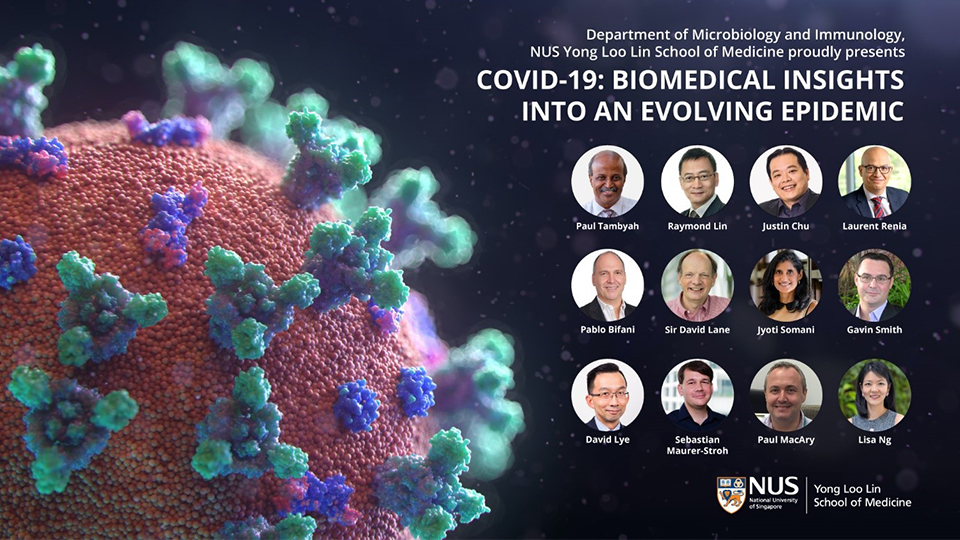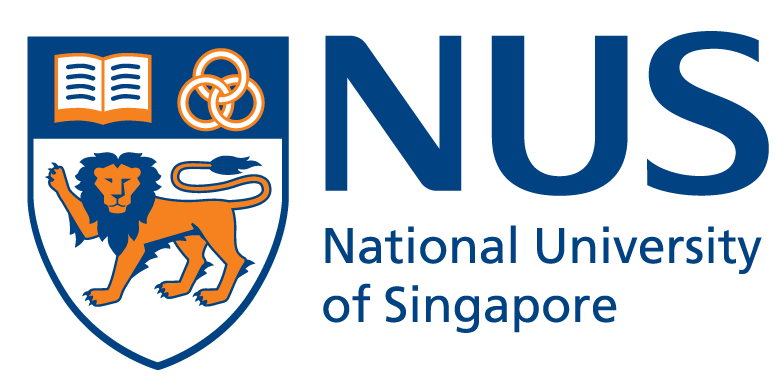The making of the world's first comprehensive webinar on SARS-CoV-2 and COVID-19
Published: 22 Sep 2020
COVID-19: Biomedical Insights into an Evolving Epidemic – How Teamwork, Collegiality and Strategy Resulted in the World’s First Comprehensive Webinar on SARS-CoV-2 and COVID-19
By Associate Professor Kevin SW TAN and Associate Professor Pablo BIFANI
Department of Microbiology and Immunology, Yong Loo Lin School of Medicine, National University of Singapore
On 6 July 2020, the Department of Microbiology and Immunology, NUS, launched a four-part, 8 session, 16-hour series on ongoing biomedical research on COVID-19 and its etiological agent, the severe acute respiratory syndrome coronavirus 2 (SARS-CoV-2). With sessions each Monday and Wednesday throughout the month of July, the webinar saw attendees from around the globe eager to hear domain experts share rare insights into the epidemiology, virus genetics, biology, pathophysiology, immunology, therapies, vaccine development and healthcare response to a complex and disturbing disease. As co-organizers of this inaugural series, we were very pleased at the successful run of this educational series, and the positive feedback we received from our colleagues and, more hearteningly, our international attendees. In the article, we would like to share our thoughts and lessons learnt from organizing this event

Lesson #1 – Nothing Sucks You in Like a Vacuum
Amid this raging pandemic, one of us (PB) noticed a dearth of educational material on the science of SARS-CoV-2 and COVID-19. Sure, there were offerings from Universities on small bite-sized aspects, predominantly epidemiology, but clearly there was a big hole missing in the biomedical landscape of COVID-19. There were no offerings on the fundamental science of clinical aspects, therapeutics, vaccine and healthcare response, at least not one packaged into a single educational course. Furthermore, controversial information pertaining to treatments options or evolution and zoonosis of the virus was being disseminated in the media, urging for a clear and science-based representation of data to the public. It was on 5 June that we met the Dean to obtain his blessings (but more importantly, his financial support) for our daring initiative. Daring because we had hoped to launch it in exactly 4 weeks from our meeting. At that point, we had absolutely nothing, save for a draft programme. It was a mission worth pursuing, as we were in an excellent position to plug that knowledge gap and perhaps make an educational contribution to the global community. In order to pull this off, we needed a clear strategy, and a crack team.
Lesson #2 – There is No ‘I’ in TEAM
Besides a generous budget, the Dean connected us with members of the School’s Communications team who were instrumental in managing media-related aspects of the webinar. The Department had recently formed an Educational Excellence Programme (DEEP) and its members were co-opted into the project committee. DEEP’s administrator was tasked to be the liaison between us and the Comms Team, the media company we engaged, invited speakers and session chairpersons. The DEEP educators handled the backend processes including managing the question and answer (Q&A) segments for each session. PB feverishly crafted the course outline and began inviting suitably engaging speakers while KT tried to keep everything together (which is harder than it sounds). We were pleasantly surprised that many experts PB approached, evidently very busy with COVID-19 research or managing healthcare responses, were willing to contribute to our course. All 16 experts were excellent speakers, thought leaders and crowd pullers. Details of our speakers can be accessed here.
Lesson #3 – Rehearse like Crazy and Prepare for Contingencies
One thing great about our Singapore culture is our ‘kiasu’ (afraid to lose) mentality. It creates a keen awareness that even the best laid plans may fail for lack of preparation and forethought. The DEEP team got together with the media company representative for numerous rehearsals and discussions. Friday evenings throughout June were spent going through the programme with the authors, DEEP team, and chairpersons. There were meetings with the speakers as well, as not many were familiar with the webinar structure and physical setup (lights, camera, action). The DEEP team established several contingency actions for the actual runs which included backing each other up for the Q&A sessions.
Lesson #4 – Formulate a Well-Structured Curriculum and Identify Engaging Experts to Share Insights
The objective of this educational series was to address the fundamental biology of SARS-CoV-2 based on our current knowledge as well as to explore key issues discussed in the media. As such, the first part of the lectures addressed the zoonotic origins of the virus, how it has spread (epidemiology), how COVID-19 is managed in the clinic as well as the early isolation and characterization in the biosafety level 3 facilities. In the process we learned how the medical community responds to novel emerging zoonosis based on previous lessons gleaned from the 2003 SARS outbreak, and how to apply them to the current pandemic. Our opening speaker, Prof Linfa Wang highlighted the importance of rapidly identifying the gaps in knowledge and filling those gaps in a swift, accurate, and collaborative manner. The following speakers did just that and presented the audience with their accounts of patient care, virus isolation, epidemiology, and predictive transmission models generated during the early stages of the pandemic. In Part 2, an in-depth analysis of the genome of the virus was presented.
Subsequently, we explored how this critical genetic information is being applied for molecular and antibody-based diagnostics. The misleading impression that the virus is evolving into an ever more virulent form was discussed as part of our understanding of SARS-CoV-2 genome evolution and biology. We discussed how closely monitoring the viral genetics is crucial to ensure the sensitivity and specificity of newly developed genetic-based molecular diagnostic techniques as well as antibody-based monitoring of the virus and convalescent patients, as changes in regions target by these kits could lead to false negative result. This introduction to antibodies led us straight into Part 3, on the immunopathology of the virus and vaccine development. We first explored the pathology of the virus as it invades the host (pathophysiology), and the host immune response to the invasion. These host-immune responses and antigenic properties of the virus were first discussed in the context of its biology and secondly on its role on diagnostics, vaccination, antibody-based therapies and prophylactic treatments. The principles of immunization and its application to on-going vaccine development were extensively discussed. Likewise, the exciting and rapidly growing field of antibody-based therapy and prophylactic treatment of infectious diseases was addressed. Finally, Part 4, addressed antiviral therapeutic research. The differences between viral-target therapies versus host-target immunomodulation were explained as well as how drug discovery at this early stage of the outbreak rely primarily on drug-repurposing rather than the discovery of new compounds. Controversial treatments plaguing the news, such as the use of hydroxychloroquine and its failure in large clinical trials were exposed by our closing speaker, Prof David Lye.
Throughout the Educational Series, the lecturers relied extensively on their experiences as clinicians and investigators in the frontline of the fight against COVID-19, often addressing some of the important advancements made in Singapore which are currently having a global impact, especially with regards to antibody-based diagnostics and antibody-based therapy.
Lesson #5 – After Execution, Follow-Through
The course ended on 29 July, and at that point, we felt a deep sense of achievement, mingled with relief and exhaustion. The chats coming through at the end of each session reinforced the importance of such educational initiatives. Regional participants were especially grateful for the opportunity to learn about the latest developments in COVID-19 research. The many words of thanks from attendees was a clear sign that our efforts had paid off. We were providing key findings on COVID-19, based on science and facts and in the process, providing a key defence against falsehoods that were dominating politics, resulting in mass confusion. The post-event survey conducted reinforced our sense that we had accomplished what we set out to do. The satisfaction rating was 4.44/5 and a score of 4.33/5 for whether the course had given the attendees a better understanding of science behind COVID-19. As one attendee responded ‘I think it was a wonderful initiative by NUS to organize the whole series, and invite a truly experienced line up of professional speakers! Really gained lots of useful information here. I loved the summaries of key points from the chairs at the end of every session as well!’
Many of the attendees had asked for access to the recordings of the webinar. The 16 hour-long sessions will be made available on the healthcare online education portal Talisium, and attendees will be informed on their availability once the recordings have been uploaded.
Afterthoughts
The whole webinar adventure gave us pause for thought. Such ambitious plans that needed to be executed within a short span of time needs a few key ingredients to ensure success:
- Organizers/leaders who truly believe in the mission and will be steadfast in its execution (lesson #1).
- The ability to galvanize an ‘A Team’ to drive the mission. This team needs to have complementary skills (admin, educators, communicatios, media support and more). Sharing a united vision ensures collegiality and teamwork (lesson #2).
- A clear strategy for execution which involves hours of open and frank discussions, rehearsals and a clear protocol for contingencies (lesson #3).
- A well-crafted lesson plan with complementary topics delivered by great speakers, providing both a micro- and macro-scale appreciation of the pandemic (lesson #4).
- It doesn’t end when the project ends. The final ingredient is a plan for follow-through, and this includes post-event surveys, debriefs and importantly, recognition for those who contributed to the event’s success.
Inspired by the triumph of this initiative and armed with the experience garnered through this educational adventure, we are in an excellent position to plan for the next instalment of our COVID-19 educational series slated for January 2021. The team is eager to embark on another learning adventure together. Won’t you join us?

